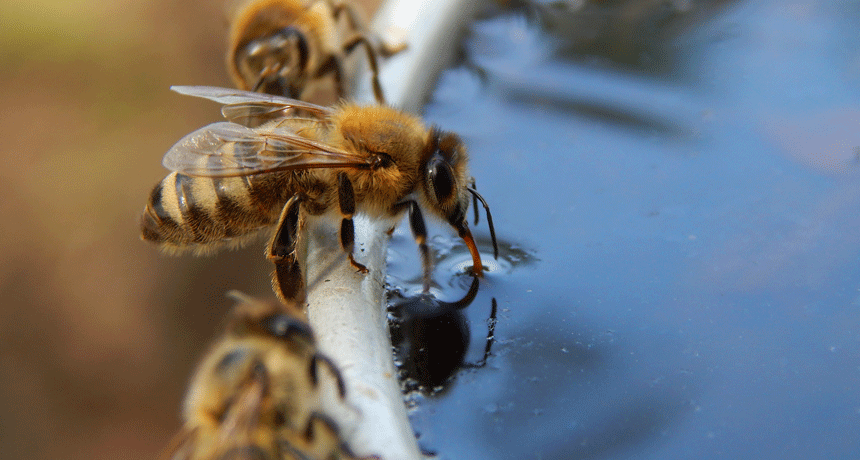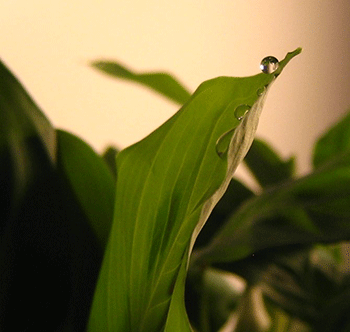Cleaning up water that bees like to drink
A Connecticut teen invented a way to reduce pesticides in the water that bees prefer to drink

Bees can't live on nectar alone. They also need to drink water. But when it comes from the tips of leaves, bees can imbibe a toxic insecticide, too, a teen shows.
Nicolefoto/iStockphoto
Share this:
- Share via email (Opens in new window) Email
- Click to share on Facebook (Opens in new window) Facebook
- Click to share on X (Opens in new window) X
- Click to share on Pinterest (Opens in new window) Pinterest
- Click to share on Reddit (Opens in new window) Reddit
- Share to Google Classroom (Opens in new window) Google Classroom
- Click to print (Opens in new window) Print
WASHINGTON, D.C. — Most people know that bees like nectar. But these insects also like to sip the water that plants push out of their leaves. If that water is full of pesticides, though, bees can ingest a dose of poison. Derek Woo, 17, wanted to see if he could clean out some of that bug-killing chemical. All he needed to add was a little charcoal.
The senior at Greenwich High School in Connecticut brought the results of his project here to the Regeneron Science Talent Search. Created by Society for Science & the Public, this yearly event brings together 40 top high school scientists from across the United States. It is sponsored by Regeneron, a company that designs new medications. The students present their projects to the public and compete for almost $2 million in prizes. (Society for Science & the Public also publishes Science News for Students and this blog.)
Derek didn’t start out with an interest in research. It developed accidentally, three years ago. That’s when he followed a friend into a meeting about his school’s research program. Teachers described how students would create their own projects and solve their own problems, he recalls. “It hooked me.”

When it was time to come up with his own project, Derek got inspired by a radio story. It described colony collapse disorder, or CCD. It’s what happens when most of the worker bees abandon a hive. Without the food these workers normally bring home, the queen and her young can starve.
Farmers also care about CCD because it threatens many of the crops that rely on bees to pollinate them. With no worker bees, the supply of peaches, blueberries, squash or other foods could run short.
Several factors can contribute to CCD, including parasites and infections. But Derek was especially worried about insecticides. Farmers use these chemicals on their crops to keep away hungry insects that could destroy their plants. But most of these chemicals will clobber harmful and helpful insects alike. Some can hurt or even kill bees.
Bees can get an extra-large dose of insecticides when they drink water that has been produced through a process called guttation (Guh-TAY-shun). At night, most plants close tiny holes in their leaves called stomata. That prevents too much water from leaving the plant. But pressure in the roots continues to push water up through the plant. Eventually, it can seep out of the edges of the leaves. If those leaves are shaped like blades, the drops may collect at the very tip.
That water isn’t pure, though. As it moves through the plant it can pick up nutrients such as sugar. And bees do love a sip of sugar. In fact, Derek observes, “They prefer [guttation water] over a pond.” The bad news: Insecticides and other chemicals can also end up in that water.
Derek wanted to see how much of an insecticide called imidacloprid (Ih-mid-ah-KLOH-prid) might end up in guttation water. To find out, he grew plants in his high school laboratory. The plants were Dracaena deremensis (Drah-SEE-nah Der-eh-MEN-sis), houseplants with long, blade-shaped leaves. He watered the soil of eight plants with clean water every other day for a week. He laced the drinking water of another eight plants with the pesticide. On the days he didn’t water the plants, Derek collected guttation water from the leaves’ tips.
He analyzed the water using a method called high-performance liquid chromatography. It separates chemicals from a mixture so they can be identified.

The insecticide didn’t just move into the leaves, the teen found. It actually became concentrated along its climb. Water at the leaf tips had four times more pesticide (per milliliter) than had the water sprayed onto the soil. Such a high dose, he notes, would kill any bees that sipped that water.
Hoping to reduce the amount of pesticide getting into the guttation water, Derek turned to biochar. This a type of charcoal that some farmers add to their soils. Biochar can help soils retain water. The same type of charcoal also can sop up certain toxic chemicals. So the teen investigated what it would do to imidacloprid. He grew a batch of plants in a mix of one part biochar to four parts soil.
The biochar indeed soaked up the pesticide. This kept most of it from reaching the leaves. The guttation water from plants grown with biochar in their soil had only 10 percent as much of the pesticide as before. But some chemical still remained in the water. Derek found about 5 molecules per one million molecules of water. This is not enough to kill a bee, the teen says, but it could be enough to make one sick.
Derek’s next goal is to convince farmers in his area to add biochar to their soils. “I’ve contacted a few farms in my area,” he says. But, he admits, it would be best for bees if farmers could stop using the pesticide. In 2013, the European Union banned imidacloprid’s use on plants to which bees are attracted. And starting this year, U.S. farmers will also be banned from spraying insecticides such as this one when bees are present.
Follow Eureka! Lab on Twitter






